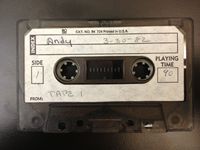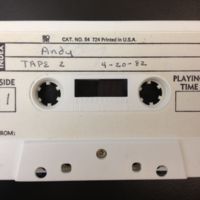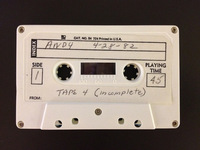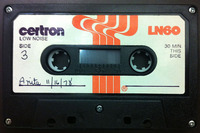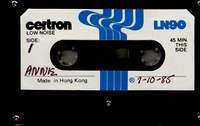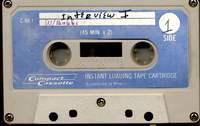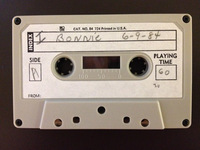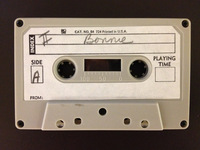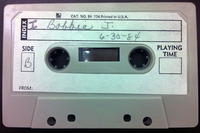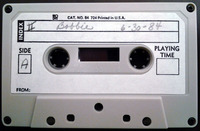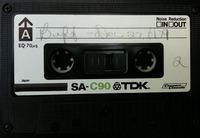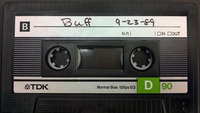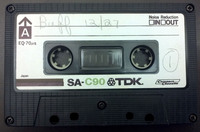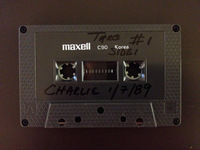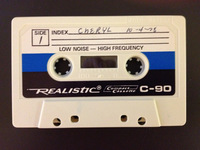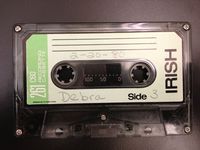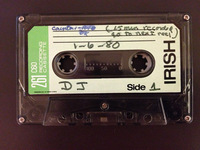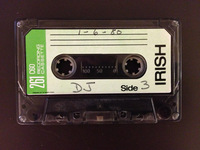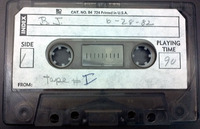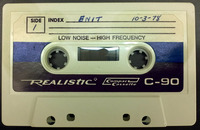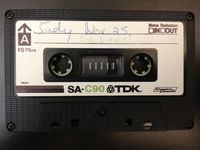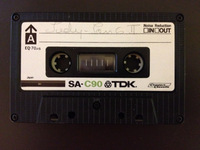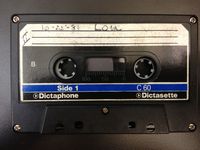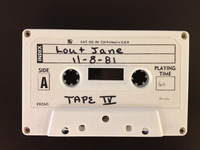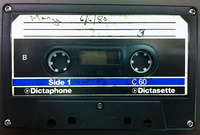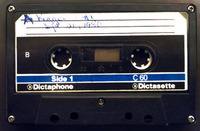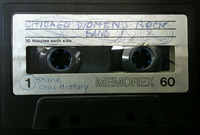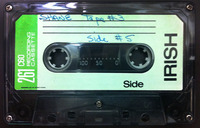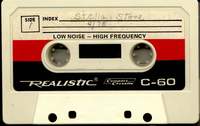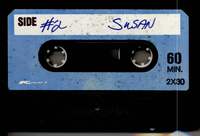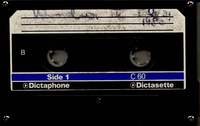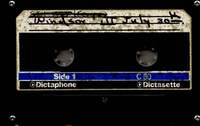
Buffalo Women's Oral History Project, 1978-1990
Title
Buffalo Women's Oral History Project, 1978-1990
Description
Part-ethnography and part-history, Boots of Leather, Slippers of Gold by Madeline Davis and Elizabeth Kennedy is an intimate history of a lesbian community in Buffalo, New York. It combines the ethnographic method of a rigorous study of a single community’s culture and identity, along with the historian’s urge to analyze the specific forces that shape these communities over time. In terms of primary sources, this historical analysis relied on the Buffalo Women’s Oral History Project. This extensive oral history project began in 1978 and extended through the next 13 years. Interview subjects were working-class lesbian women from Buffalo, New York who described their experiences during the period from the mid-1930s to the early 1960s.
These recordings of interviews with working-class lesbians are rich with wisdom, insight and emotion. Interviews discuss a wide range of topics including butch/femme roles, gendered sexuality, relationships, family dynamics, the bar scene, religion, realization of homosexuality, coming out, lesbian mothers, oppression, police brutality, race, gay rights movements, women in the military, youth, and identity. They offer dynamic first-person perspectives of the place and time before the emergence of the gay and lesbian liberation movements. From these stories surface the personal struggles and triumphs of the lesbian community during an intensely oppressive time.
For recordings related to the publication of Boots of Leather, Slippers of Gold, see Boots of Leather, Slippers of Gold: Related Audio Recordings, 1977-1990.
The recordings were donated to the archives by Madeline Davis and Elizabeth Kennedy and were subsequently digitized by students from the Pratt Institute, Projects in Digital Archives class, LIS-665.
These recordings of interviews with working-class lesbians are rich with wisdom, insight and emotion. Interviews discuss a wide range of topics including butch/femme roles, gendered sexuality, relationships, family dynamics, the bar scene, religion, realization of homosexuality, coming out, lesbian mothers, oppression, police brutality, race, gay rights movements, women in the military, youth, and identity. They offer dynamic first-person perspectives of the place and time before the emergence of the gay and lesbian liberation movements. From these stories surface the personal struggles and triumphs of the lesbian community during an intensely oppressive time.
For recordings related to the publication of Boots of Leather, Slippers of Gold, see Boots of Leather, Slippers of Gold: Related Audio Recordings, 1977-1990.
The recordings were donated to the archives by Madeline Davis and Elizabeth Kennedy and were subsequently digitized by students from the Pratt Institute, Projects in Digital Archives class, LIS-665.
Collection Items
-
Andy, March 30, 1982 (Tape 1)
Andy discusses the history of gay rights in Buffalo, New York, and describes how it feels like to be open about her sexual identity. She shares some of her childhood and early adulthood experiences in the 1950s and 60s –her first relationships and confronting the risk of losing her job. Other topics discussed include the gay and lesbian bar scene, raids, prostitution, butch and femme roles, and Andy’s experience within the African American gay community. -
Andy, April 20, 1982 (Tape 2)
Andy further discusses how she came to construct her butch image. She recalls getting into fights with men and having to give up good jobs because she refused to give up her queer image and identity. She discusses her clash with a teacher when she was in school in the 1950s. She describes her relationship with a prostitute and other close relationships. On side B she talks about breaking into the butch scene and coming out. Andy talks about gay bars and places queer women were welcome or not. She discusses fashion and explains why they wore their t-shirts backward. -
Andy, April 28, 1982 (Tape 4)
At the start of the interview, Andy talks about the first time someone asked her about sex. She talks about her experience going with hookers. She discusses butches and femmes and argues that femmes aren't "true" lesbians. -
Anita, November 16, 1978 (Tape 1)
Anita talks about her first encounters with a relationship with a woman. She then speaks about the difficulties of raising her child. She also talks about the roles of Butch and Femme. -
Anita, undated (Tape 2)
Anita talks about being in an interracial relationship with a white woman, and the roles of butch and femme. -
Ann II, October 23, 1980 (Tape 2)
Ann describes what she looked for in a women. Discusses the clothing change among lesbian women. Explains some of her relationship experience with women. -
Annie, July 10, 1985 (Tape 1)
A woman talks about her time married to a man as compared to her time in a relationship with a woman, and the pros and cons of both. -
Bobbi (Tape 1)
Side A:
The interview discusses what coming out was like for the interviewee and the reactions of her family members.
Side B:
Interviewee discusses dating and having her first love affair. The interview talks about the differences in reactions of people when she came out during the 1960s and how that affected what she did and who she hung out with. She discusses the change in going from a group of people who accepted her being gay to a group of people who felt guilty of being gay. -
Bonnie, June 9, 1984 (Tape 1)
Bonnie discusses the lesbian community in which she came out and lived during the 1960s. She describes the difference of experience for butch and femme lesbians in public during this time, the roles butches and femmes play within relationships, and the social expectations involved. Other topics include Bonnie's lesbian mother, alcoholism, lesbian bars, Bonnie becoming actively gay at Catholic school, her way of flirting, and monogamy and infidelity within the lesbian community. -
Bonnie, June 9, 1984 (Tape 2)
Bonnie discusses rules of conduct within the lesbian community, including domestic violence, beginning and ending relationships, identifying as butch or femme, and domestic roles. Other topics include prostitution with women and men, bisexuality, definitions of lesbianism, types of relationships, and her rules of attraction. -
Bobbie, June 30, 1984 (Tape 1)
She thinks people have the wrong opinion of lesbians, she says she feels alone in the bars, role playing was important that someone should be the more aggressive person in a relationship, talks about how she needs a butch in a relationship, thought of herself as a femme although she didn't dress feminine, describes a "dyke person", bar atmosphere and how she went to a bar every night to hit on the bartender, how much she enjoyed the bar scenes, prostitution, story about how she was abducted and raped by 3 men, about how she was in an abusive relationship, spending time in a correctional facility, sexual relationships while in jail -
Bobbie, June 30, 1984 (Tape 2)
Bobbie speaks on the nature of her various relationships, including patterns of sex and cohabitation, being confused about her significant other identifying as a man in public, she addresses the existence of her children, using men after prison to live and make money, attending gay reorientation church, her sexual practices, and the subject of the "Untouchable". -
Sara Brown, 1978
Sara Brown discusses her experiences with her previous female partners. She talks about her childhood and the influence that her family and Catholic School had on her life as she was growing up. She also discusses the difficulty she has had in coming out to her parents in later life. -
Buff, October, 1978
Talks about community tattoos, race, being butch, the challanges of identity and expectations. Touches on past sexual abuse by her father, gender roles, identity, learning about gay life and her discovery process, friendship, clothing and identity, her marriage to a gay man, her suicide attempt. -
Buff, September 23, 1979
Talks about dating a prostitute, lesbian prostitutes, lesbians and butches having sex with men, lesbian pregnancy, clothing styles, -
Buff, December 27, 1979
Buff discusses the impact of the Metropolitan Community church on her life and the gay-rights movement. Mentions activities in Tucson, AZ. She stresses that current lesbians should know that there is more to life than the bars, but that in her time in Buffalo she didn't feel there were places for community outside of them. Mentions her time in the army, realizing she was homosexual, and coming out. Discusses her time in the army, lesbians in the military, being in Seattle and Germany with the military just after the Korean war. She talks about the differences in gay identity and self identity in the past compared to now. -
Carol, October 17, 1978
Bad sound quality. Discusses that she doesn't think of her community of a lesbian community, though she can contribute to the lesbian community. Says she now stays away from gay bar communities because she is a teacher. Discusses running into students at bars, relationships, family. -
Charlie, January 7, 1989
Charlie talks about her life as a lesbian after twice being married to men. She discusses having two long committed lesbian relationships and the differing dynamics between her and those partners as a reflection of her age and comfort with herself. Charlie identifies as a Femme, and the Butch / Femme dynamic is explored. There is also discussion of her mother’s reaction to her lifestyle and the not somewhat non-forthcoming dynamic with her daughter.
Note: To listen to this recording, please contact the Lesbian Herstory Archives to make an appointment. -
Cheryl, October 4, 1978 (Tape 1)
Side A: Cheryl discusses her experiences and the stereotypes that were associated with lesbians in college when she first first came out.
Side B: Cheryl discusses her relationships, including sexual relationships and partnerships. She shares her experiences and opinions about affairs, and monogamous and non-monogamous relationships. Generational differences within the lesbian community are also discussed. -
Cheryl, October 4, 1978 (Tape 2)
In the first few minutes of this tape Cheryl and the interviewer have a casual conversation discussing topics as, a gay computer dating services and gays in the service
Later in the tape Cheryl discusses how her relationships fall into patterns. From there she list characteristic she is attractive to in a partner.
-
Cindy and Joan
Cindy or Joan (speaker unclear) discusses her experience of growing up in a working class family. She also discusses going to bars as she got older, and her relationships with women. She describes lesbians being harassed by police officers in the past. She also describes how her car was vandalized once, which she thinks was because she is a lesbian.
Speakers' identities are unclear throughout. Recording label identifies Cindy and Joan but it is hard to tell if there are actually two separate speakers.
Sound quality is poor. Tape cuts off abruptly at the end. -
Debra, February 20, 1980 (Tape 1)
Debra discusses her experiences as a lesbian. She talks about her first lesbian relationship when she was 12, how she was married for one day, how her mother knew something was different about her, and how her sister figured out she was a lesbian because she was only married for one day.
She talks about her relationships with women, how she never openly acknowledged that she was gay but if she was asked she wouldn’t deny it.
They discuss monogamy, she was mostly faithful, but she also talks about jealous partners and how when one is accused of things, one might as well and go ahead and do it.
She doesn’t believe that a lesbian relationship is any different than a straight relationship.
They discuss bars and areas in Buffalo that she would frequent: Moon Glow bar, Pearls bar, Ralph Martins, Ryan’s Hotel, Little Harlem. They also discuss dating rituals, fashion, and relationship/ courting roles. -
Debra, February 20, 1980 (Tape 2)
Discusses her child, a son. He was the product of her one-day marriage. She kept him for about 8 months and then her brother and his wife took him and raised him. He would spend the summers with her until he was 12 and then he lived with her and spent the summers with her brother and his wife.
Believes lesbians make better mothers because they know more. She didn’t want her son to go into gay life because she felt it would be difficult for him, she doesn’t believe that gay men relationships last. She believes you can teach someone not to be gay.
They talk about gay men and lesbian relationships and social interactions. She would call upon her gay male friends to be her date to events that she needed a date, also sometimes family events. They talk about marriages between a gay man and gay woman. Debra says that she knew quite a few couples who had done that to put up a front, but that those relationships always worked out well. Debra also talks about marriage between two women. She never wanted to get married but knew women who did.
They also discuss alcoholism and drugs among the gay community.
On the second tape, Debra further discusses fights in the lesbian community. Madeline asks if she knew any lesbians who played sports in the 1940s and 1950s. Debra believes lesbians played sports but cannot definitely say so. -
DJ, January 6, 1980 (Tape 1)
DJ discusses the time she went to the hospital and was diagnosed as a homosexual. She remembers that the doctor suggested she try going out with a man to determine the extent of her feelings toward women. She also recalls that the doctor told her she must learn to live with society and to control her emotions in public. -
DJ, January 6, 1980 (Tape 2)
DJ discusses her early experiences with women as a teenager, her feelings of being a tomboy, and her coming-out experience. She discusses her experiences in the bar scene in Buffalo in the 1950s, and describes ways in which women would interact with each other, but publicly and privately. DJ also discusses roles in relationships, particularly the butch and the femme. -
DJ, January 6, 1980 (Tape 3)
Side A: DJ continues her interview from tape SPW513. She finishes discussing her romantic relationships then moves on to discuss gay literature, specifically The Well of Loneliness. The topic of workplace discrimination is mentioned. DJ discusses relationships in the community through the venue of gay and straight bars. Relationships between straight men, lesbians, and bisexual women are discussed as well as race relations. Side B: DJ covers the topic of prostitution in the lesbian community. She speaks about the choice some lesbians make to marry men and have kids. -
Dorothy, October 2, 1981 (Tape 1)
Side A: Dorothy discusses her personal life and how she came to discover that she was a lesbian. She talks about her marriage and separation. She discusses her relationships with women, all of which were long-term. Dorothy talks about her job in engineering as a tool designer and the fact that she performed a man's work for a man's salary. She discusses lesbian social life during the 1930s, 1940s, and 1950s and names several popular bars including Eddy's Tavern, Ralph Martin. She talks about her developing alcoholism and the prominence of this disease among lesbians in general, perhaps as a result of their uncertainty about life. Dorothy also talks about butch and femme roles in lesbianism, stating that she doesn't identify herself with either role despite the fact that the butches identified her as one of them.
Side B: Dorothy continues the discussion of roles in lesbianism and the division between the two groups in bars. She says that her "crowd" did not distinguish between these two groups and she ultimately stopped going to bars, partly as a result of the need for role division. She discusses in some depth her problem with alcohol and talks about her membership in Alcoholics Anonymous. She talks about how she decided that she was a lesbian and gives further details about her first relationship. She also speculates on whether or not other people knew she was a lesbian, including her mother and acquaintances such as her landlord. She says that she has never had any problems with people discriminating against her. Dorothy also continues to talk about the social dynamics of bars in Buffalo. -
Dorothy, October 2, 1981 (Tape 2)
Dorothy talks generally of leisure activities, relationships, and sexual relations. She then talks at length about one long-term relationship with Harriette, mentioning their business, break up, life-long friendship, and Harriettes other relationships.
She talks first of weekend activities or leisure activities such as house parties, picnics, and going to bars. She talks in general about sexual relations, mentioning "daisy chain" sex, and attitudes towards sex and equality in love-making. She talks in general about long-term relationships and breaking up. She then answers questions and talks at length about her long-term relationship with Harriette, their break up and lasting friendship. She mentions their first car and the business they owned together. She talks of monogamy. She talks of Harriette's later marriage and other relationships. Dorothy talks of her opinion of bi-sexuality and of Harriette's marriage and relationships.
-
Dorothy, October 26, 1981 (Tape 1)
Side A
Dorothy discusses lesbians in the military during World War II with regard to her friend Betty, a lesbian marine who feared her phone was tapped. She refers to it as a 'witch hunt'. Dorothy discusses lesbian bars in Buffalo in the 1940s -1950s, and talks about friendships and butch and femme roles.
Side B
Dorothy discusses her break up with her girlfriend of 13 years, Charlotte. She talks about their courtship, sexuality, home life, and their families, who were never formally told they were a couple. While talking about the break up she mentions the deed to a cottage they shared and losing personal property in the breakup. Dorothy mentions seeking help from a lawyer and a lesbian psychologist in the 1950s. Dorothy discusses that she once considered suicide after a breakup.
-
Dorothy, October 26, 1981 (Tape 2)
Side A
Dorothy discusses how women met one another, sexuality, and her various relationships. Particular focus is on her 10 year relationship with her girlfriend during the mid 1950s to mid 1960s.
Side B
Dorothy discusses how she feels about children and the fact that she never any. She gives her opinion on two women raising a child, and talks about her friends who are now married to men who raised children. In addition, she continues her thoughts on sexuality and butch-femme roles.
-
Dorothy, October 26, 1981 (Tape 3)
Dorothy discusses her lifelong identity as a lesbian and her uncharacteristic history in adopting both the butch and femme roles in prior relationships. She talks about being the child of a single mother (her father died when she was two years old) and also describes her hobbies. She says she has always been very mechanically inclined and has also always been an avid reader. She suspects that being an avid reader influenced her ability to understand and be accepting of herself. She also discusses her education and career and her treatment as a lesbian on the job. She was the first female member of the American Society of Tool Designers and later became a technical librarian and engineering researcher. She also speaks about her friendships and non-sexual relationships with both gay and straight women. She notes the differences between those relationships and how her mannerisms and level of self-consciousness also differ in those interactions. -
Elaine, April 17, 1980 (Tape 1)
Discussion centers on bars in Buffalo in the late 1950s and into the 1960s, in particular Bingo -
Elaine, June 28, 1982 (Tape 2)
Discussion on early childhood, being Canadian but growing up on an Indian Reservation near Syracuse. Also discusses being the head of a black gang, her relationship with her mother and abusive stepfather, and the jail time she spent for his murder, finding work (while hiding she was gay) and relationships. -
Enit, October 3, 1978 (Tape 1)
Enit discusses facing her sexuality at the age of 12 and coming out to her family despite her frustration at their lack of acceptance. She goes on to discuss her social life and dating in Buffalo, NY, noting how she used to meet women at bars but that her social activities have changed with age. She discusses her participation in the Erie Picnics held for gay men and women in Pennsylvania. She is 47 at the time of the interview. -
Enit, October 3, 1978 (Tape 2)
Enit discusses how her perception of Lesbian oppression has changed over time. She also talks about acceptance in the work place and how professionals view Lesbians. Enit explains that her personal interests have changed with age and that her hobby is dance. She finishes by discussing her interactions with straight women and the support she gets from her Lesbian friends. -
Joan with Donna and Doris, April, 1978
Joan talks about how she went to jail and her experiences while she was held there. -
Joan, September 11, 1978 (Tape 1)
Side A: Joan discusses the distinction between butch and femme lesbians, the differences between the white and black gay communities, the Buffalo lesbian bar scene, and coming out in the 1960s.
Side B: Joan discusses the class divisions in the lesbian community, the university gay scene, and her personal, professional, and romantic history. -
Joan, September 11, 1978 (Tape 2)
Joan discusses permanent relationships and other lesbians' relationships, dating process, how she and others approach lesbians they are interested in, and terminologies in dating (example: when do you start "going" with someone, and is it actually called "going"?). She identifies herself first as a lesbian, second as an African American. She talks about racism in the white lesbian community and the acceptance of black lesbians in black communities, which she says has to do with class. She talks about the black movement and gay/women's liberation in Buffalo. She describes how she's dressed. -
Joe, April 18, 1979 (Tape 1)
Side A: Joe talks about the social atmosphere in the 1920s through the 1940s. He talks about Service Clubs and Music Circles as vehicles for social interaction but claims not to know of any exclusively gay or lesbian social groups. He also talks about the one gay bar in town in the 1930s and '40s and calls it "middle class at best."
Side B: Joe talks about social clubs (all men's clubs) and how gay society functioned within these clubs. He also talked about sports and gay women at the time. -
Joe, April 18, 1979 (Tape 2)
Joe offers suggestions for local history sources, research materials, and other interview subjects. He also shares anecdotes of his travels to San Francisco. -
Judy, February 5, [year unknown]
Judy describes her experiences over the past thirty years up to the point of the interview. Topics discussed include cheating (“playing around”), polygamous lesbian relationships, fights in bars, holiday celebrations, friendship, same-sex marriage, religion, drinking, drugs, crime, mental health and treatment of lesbian women, the commonality of lesbian women seeking psychiatric treatment, the working environment for lesbian women, living alone, families of lesbian women, and one case of a lesbian woman raising a son. Judy believes that lesbian women should not raise children and has an extensive discussion about her reasoning. She ends the interview by discussing movie stars and entertainers that were popular among the lesbian community in the 1930s and 1940s. -
Judy, November 25, [year unknown]
Judy shares detailed aspects of her life as a gay woman in the 1940s; she talks about the first time she felt attracted to another girl at age nine, and what it felt like when she came out in 1944. The interview brings to light the array of conflicts and fears she experienced growing up at the heart of a devout Italian family in Buffalo, and the difficulties faced as a young woman living in New York City at the end of World War II. Some of the topics discussed include working conditions, relationships, gay and lesbian bar scenes, popular music, butch and femme, and clothing styles. -
Judy, January 6, [year unknown]
Judy talks about her relationships with three different women and the role they each played in the relationship. She talks about gender identities and one relationship with a woman who wanted to be a man and had very mixed gender roles. She talks about not being able to talk about her relationships with her mother, yet comparing her relationship to that of her mother and father. She speaks about losing sexual interest in her partner and moving from an intimate relationship to just a friendship. -
Judy T., 1978
Judy discusses butch and femme identities, social interactions, and role-play within relationships. She expresses relief over how these once rigid demarcations of identity have become more flexible within the lesbian community. Later, however, she notes "class" differences that continue to striate lesbians as a social group.
The social conditions, the acceptance of lesbians, and the "openness" of homosexuals are compared between New York, Florida, and Toronto. References are made to anti-gay activist Anita Bryant and others who put social pressure on lesbians to stay closeted.
Additionally, Judy touches upon negotiating workplace discrimination and "nosy" neighbors. She briefly mentions her relationship with her family and what it was like growing up in Buffalo.
-
Judy T., 1979 (Tape 1)
Side A: Judy discusses some of the bars she used to frequent, and her changing views of sex.
Side B: Judy discusses her past relationships and the ways in which she feels the treatment of women at jobs has changed. -
Judy T., 1979 (Tape 2)
Judy discusses her views of gay men, including her belief that all so-called gay men are in fact bisexual. -
Linda, November 19, 1978 (Tape 1)
Linda talks about her relationships and the idea there are no longer clearly defined lesbian roles (i.e. butch and femme) in relationships, as there were when she first came out in the 1960s. She describes her family life growing up and when she came out to her family. -
Linda, November 19, 1978 (Tape 2)
Linda discusses work and how her coworkers knew that she is a lesbian, which did not bother them. She recalls beginning to wear men's clothes to work in the 1970s when women began to wear pants. Linda discusses her relationship, and how her life centers around her lover. She believes that the younger generation is less monogamous than hers. Linda also discusses butch and femme dynamics in relationships.
The sound quality is poor in the beginning. The tape cuts off abruptly at the end. -
Lou, October 21, 1981 (Tape 2)
Lou discusses her experience raising children as a lesbian woman, discussing at length her love of children, and wanting them to have a better life then she did. She also discusses her experience with police harassment as both a black women, and a lesbian.
Side B includes songs about lesbians, their lives and realities, and their relationships with children and their families. -
Lou and Jane, November 8, 1981 (Tape 3)
The interviewee discusses the time she considered getting a sex change. She talks about religion. At the end she talks about getting respect. There is significant distortion at the end of the tape.
Lou and Jane discuss their sexual relationship and further aspects of female sexuality. -
Lou and Jane, November 8, 1981 (Tape 4)
Lou and Jane discuss what life is like as an interracial lesbian couple. They discuss how white "studs" feel threatened by black "studs", feeling they will steal their women. Alcoholism is briefly discussed. They also discuss having to tell lies to their family to prevent them from knowing about their sexuality.
On Side B- Jane begins with her experience as Fem lesbian, and her difficulty with what that means to her. She talks about her difficulty with coming "out", and then is interrupted by one of their children.
Lou discusses her relationship with her Fem partner (Jane), as someone who self-identifies as a Butch. She discusses her choices in life, and her commitment to her relationship, her partner, and her family. She also talks about her disillusionment with the future, and her lack of hope for change. Lou references Jane's feelings, and her hope for Jane to recognize what it means to be a Fem.
-
Marge, June 4, 1980
Marge speaks of the bars in Buffalo, NY in the 1950s, specifically Bingo's, Chesterfield, Dugan's, Mardi Gras, and Carousel, which had more of an established lesbian clientele. She tells how Carousel changed from a lesbian to gay crowd in the late 1950s and eventually closed because of allowing "careless" behavior. She felt patrons of gay bars in the 1950s were more respectful than at the time of the interview in 1980. Marge was arrested for serving a minor female, which she felt was an attempt to close the bar where she worked. The tape cuts off at the end of the second side. -
Mary K., December 12, 1981
Side A: Mary discusses her experiences in the gay community in Buffalo in the 1950s. She discusses in detail the gay bar scene and describes the clientele at the Carousel, Bingo's, and the Chesterfield. The interviewee also describes the dynamic of the relationships she experienced and observed in terms of both race and gender identity. Mary also discusses prostitution in the Buffalo community during the 1950s. She describes some of her own sexual and relationship experiences.
Side B: Continuing the conversation from Side A, Mary discusses in more detail the types of people she observed in the various bars in Buffalo, as well as her family. She explains that she got along with her family, but never came out to them, in spite of which her father never questioned her about her relationships or pressured her to get married. She also discusses the socio-economic status of various gay communities throughout Buffalo. Both the interviewer and the interviewee discuss butch and femme identities within the larger context of the lesbian community in Buffalo. Mary speaks in more detail about her social experiences. -
Mary T., July 7, 1978 (Tape 1)
Side A: Mary briefly describes her childhood and family dynamics. Mary and the interviewer then discuss the first time Mary recognized being different and her thoughts on desiring women at a young age, yet not knowing about lesbianism as a concept or about the lesbian community. Mary then recalls the first time she encountered the word "lesbian" when she joined the U.S. Air Force and describes her experiences with women while in the service. Mary talks about being a lesbian in the military, the investigation into her conduct, and her dishonorable discharge. After Mary got another job, she started going to a bar in Buffalo, N.Y., and she talks about the other lesbians she met there. Mary then discovered other bars and talks about the scene as well as the role-playing of butch and femme.
Constant whirring noise that stops about 10 minutes into the recording.
Side B: Mary continues the discussion on butch and femme role-playing. She elaborates on fights, holding down jobs, and being "out." She also explains the relationships lesbians had with gay men in Buffalo, N.Y., and the bar scene dynamics of mixed, gay, or lesbian bars. Mary and the interviewer discuss gay activism and the difficulties of being involved in activism at that time. Mary also describes outings where there was a risk of being visible as a group, such as going on picnics or renting cottages. She elaborates on her experience with social dynamics like cliques and having heterosexual friends within the lesbian and gay community. Mary then expands upon the nature of her relationships with women as well as with black lesbians - racial prejudice and relationships are discussed.
Constant whirring noise that stops about 5 minutes into the recording. -
Mary Ann, October 15, 1988 (Tape 1)
Side A: Mary Ann discusses her experiences going out in public with her girlfriends, and the treatment they receive at restaurants, bars, and on the street. She mentions that their public treatment is very often instigated by the masculine way her partners are dressed; she herself has always been very femme. Mary Ann talks about her incarceration for robbery, and her time in a psychiatric hospital for depression and attempted suicide.
Side B: Mary Ann continues to discuss her time in jail. She took on a butch look, and began to receive small gifts under her cell door from femme girls in other divisions. She developed relationships with different girls that she worked with while in jail, and talks about lookouts, or "chickies," standing watch for girls who were with their partners in the showers or elsewhere. She then talks about her sex life with a long-term partner of 22 years, with whom she raised foster children. Later, she touches on her job as a dancer at Buffalo clubs, and a two-year period when she worked as a prostitute. -
Mary Ann, October 15, 1988 (Tape 2)
Mary Ann talks about posing as a prostitute for men in a straight bar. She would arrange a meet-up location and then she and two girl friends would overpower and rob men. She describes several muggings she and her two friends carried out. One happened in a hotel; another took place in a man's house with his family there. She claims she and her friends never hurt anybody "more than they had to." Mary Ann also talks about the distinction between gay bars and bars where she would go to hustle. Gay bars were places to have fun with friends and not for prostitution. In one aside, the interviewer asks Mary Ann why she calls her girlfriend "my man," to which she replies that's the way her lover wanted to be addressed. -
Pat, June 6, 1978 (Tape 1)
Side A: Pat discusses her definition of lesbianism and her attitude towards “radical lesbians.” She also discusses her background, including her relationship with her family and her experience at an all-girls Catholic school. She talks about how and when she realized she was a lesbian and describes her early relationships with women. She discusses leaving home and experiencing gay bars for the first time in the 1950s. Finally, she discusses butch and femme roles and how they have changed.
Side B: Pat discusses why she does not have many gay friends and why she does not identify with the lesbian community. She talks about her relationships and her feelings about sex. -
Pat, June 6, 1978 (Tape 2)
Side A: Pat talks about her childhood in North Port, N.Y., her relationship with her parents and siblings. She goes into detail about her estranged relationship with her older sister. She describes when she first knew that she was a lesbian and tells the history of her relationships with women. She starts with her first affair at age 13, with a nun from her Catholic school - Sister Eugenie - to a relationship she had with Maryann (Marty). She describes her time at nursing school in Niagara Falls, N.Y., and the gay bars she frequented until she moved to Florida with her then girlfriend. She says she moved to Buffalo, N.Y., in the late 1950s, and describes the Buffalo bar scene, mentioning Dingles, Mardi Gras, the Chesterfield, the Carousel and the Carol Hotel. Pat mentions that the Carousel was very elite, something she did not like. This leads her into a discussion on “role play†and how important it was to distinguish oneself as either a butch or a femme. She classified herself as butch, but stated that she was very uncomfortable with the label and now prefers to be less overt.
Side B: In this interview Pat talks about how she does not like or feel comfortable in the gay community. She has never identified with it, or been made to feel welcome. This is one of the reasons that she does not maintain friendships with other lesbians, unless she is having a sexual relationship with them. She mentions being victimized and physically assaulted because she was a butch lesbian. Interviewer Madeline enters the discussion, speaking about her own sexual experiences with women. Madeline classifies Pat as “untouchable,†something that Pat denies, stating that she is simply very private. She feels that sex is a necessary but not important part of a relationship; it is something that is never sought or welcomed. She is suspicious of those who claim to experience sexual pleasure, including Madeline. -
Pat G., May 21, [year unknown] (Tape 1)
Side A: Pat discusses her experiences as an African American lesbian. She developed friendships and relationships with both white and black gay women in the 1950s. She denies there were any racial tension in the Buffalo lesbian community; Pat says her experience was very inclusive. She also discusses experiencing police harassment, but says that she longer experiences discrimination from law enforcement. Pat discusses her wardrobe in the 1950s, which was composed of mens' clothing, and where she used to shop.
Side B: Pat discusses her friendship and romantic relationship with Jerry Jones, a male impersonator, who was well known in the 1950s Buffalo lesbian community. Pat discusses her move to Albany, N.Y., in the late 1950s and the birth of her daughter in 1957. She also mentions her experiences at after-hour bars which were only open to African Americans. While she used to frequent them in her early years, she no longer goes. Pat identifies as a butch lesbian and discusses the differences between butches and femmes. When she was younger she did not allow her partner to touch her during sex, but is much more open to the idea now. According to Pat, many butch lesbians did not receive sexual contact from their partners. -
Pat G., May 21, [year unknown] (Tape 2)
Pat shows family photos. She says several of her family members were gay, including her mother and brother. She talks about bars, the 557 and 217, with racially mixed clientele. She describes violence when straight men tried to dance with gay women. She mentions other favorite bars from the 1950s: the Chesterfield, the KittyCat, Club Coco, the 469. Pat describes her relationships, many of which involved "messing around on and off" for many years. She describes coming out to her mother at age 13, and talks about the "white girls from Canada" (lesbians) who were her mother's friends. -
Pat and DJ, November 11, 1986 (Tape 1)
Side A: Liz and Madeline ask Pat and DJ for feedback on a draft of "Boots of Leather, Slippers of Gold." Pat claims the book paints too rosy a picture of lesbian life, underplaying the prejudice most lesbians encountered in the 1940s and '50s. Both talk about the Buffalo bar scene in the 1940s and '50s: mentioned are Carousel, Bingo's, the Chesterfield, Ralph Martin's, the Mardi Gras, and the Midtown. The discussion shifts to relationships, faithfulness, and prostitutes.
Recording has loud feedback sounds and squeaks at the beginning.
Side B: Pat and DJ discuss bar denizens vs. lesbians who did not frequent bars and the "class" distinction there, and also the way non-butch lesbians looked down on butches. DJ describes how her long-term relationships were analogous to marriage, where she was the breadwinner and her partners were housewives who perhaps worked but did not "provide." Both discuss the fact that in the 1940s and '50s butches had the freedom to have affairs whereas femmes were expected to be faithful. This created an atmosphere of mistrust in which monogamous long-term relationships became very difficult.
Recording has loud squeaks at the beginning, hisses throughout, and cuts off abruptly at the end. -
Pat and DJ, November 11, 1986 (Tape 2)
Side A: Pat and DJ continue the discussion of relationships during the 1950s from tape cassette SPW457. The two women discuss aspects of how to make relationships long-lasting and the importance or lack thereof of sexual intimacy in relationships. Both Pat and DJ discuss personal opinions related to intimacy in relationships, particularly in long-term relationships. The discussion then turns to types of attraction and intimacy.
Side B: Pat and DJ continue to discuss relationships during the 1950s and talk about reasons for breaking up. The discussion revolves around the importance of taking care of a woman and being able to satisfy her needs. The two women discuss the negative stigma of cheating. The discussion turns to take pride in a partner and the importance of her appearance and physical presence. Pat and DJ also talk about the presence of violence during relationships in the 1950s, listing insecurity between partners as the main reason. The two women speak specifically of violence in bars as a result of talking to another woman’s lady or challenging femmes in relationships to talk to other women. They discuss how much of this behavior was learned from lesbian role models of the 1940s. -
Pat and DJ, November 11, 1986 (Tape 3)
Side A: Pat and DJ discuss the characteristics of femme identity. The interviewers say they are looking to interview more femmes, which leads to a discussion of the names and locations of lesbians who were a part of the community in the 1940s. The interviewers also mention the difficulties of interviewing lesbians who have not come out. The group discusses why butches are more willing to talk. Pat talks about her time at the Good Shepherd home. There is a brief discussion about the role of lesbians in World War II.
Cut off at 0:14:55
Side B: The group continues their discussion of the interview process, including who is willing to talk and who is not, as well as who will use their names and who will not. There is more discussion about beatings. Pat tells of coming out to her mother. Her mother only worries about the violence Pat is subjected to, on account of being butch. There is a long discussion about the nature of breakups and their aftermath. The group discusses the role of third parties in most breakups and the way a butch or femme reacts to a breakup. The issue of "passing" comes up, and Pat talks about working as a cab driver and passing as a man. Often, the children of femmes did not know that their mothers' partners were actually women. The interview concludes with a description of the rules for asking other butches' girlfriends to dance, and the fights that sometimes ensued. This point in the discussion highlights the difference between the generation of the interviewees and the generation of the interviewers. -
Paula, January 18, 1990 (Tape 1)
Side A: Paula describes various locations where gay men and women would meet each other, like Kleinman's Corner and bars such as Ralph Martin's. Often these locations also served as hubs for sex workers. She speaks about the rigidly defined roles of "butch" and "femme" provided for lesbians during the 1940s. Paula talks about her life as femme and being married to a man who introduced her to gay/lesbian life. She discusses her sexual life and the type of sex that women had with each other in the 1940s, specifically within the strict binary of butch and femme. Paula recalls the social life at bars, such as Ralph Martin's, which included dancing, drag shows, prostitution, and drugs.
Side B: Paula speaks about her family life in relation to her sexual identity. She talks about her husband's fast lifestyle and her changing preferences eventually causing the dissolution of their marriage. Paula mentions the types of employment she has had, including working in department stores, as a waitress, as a desk clerk at the Genesee Hotel, and on the assembly line at Bell Aircraft. She speaks more about various bars that she went to: Pat's, Dugan's, the Carousel, and the Carlton Hotel. She talks about a long-term relationship that she had, after her divorce, that lasted ten years, as well as traveling out of the Buffalo area to places like Florida, California, and Utica, N.Y.
The recording cuts off abruptly after 23 minutes. -
Paula, January 18, 1990 (Tape 2)
Paula describes the absence of love and romance in her relationships with women, but later in the interviews describes a relationship after her divorce. She mentions one-night stands and sexual experiences she had with friends, and the importance of these friendships to her. Paula mentions that she was married and had children, and would go out to bars at night with her friends or alone. -
Phil, January 9, 1980
Side 3: Phil begins the interview by discussing the dynamics of living with her lover and husband under the same roof, as well her lack of shame or guilt in being gay. She then talks about guilt among other lesbians she knew. Related to this, she discusses reasons people were not public about their lesbian identity, including work and family commitments. She spends the majority of this side of the tape talking about her long-term, intimate relationship with her best friend. She discusses the difference between butch and femme friends, as well as the distinct features of a close friend versus a lover. -
Phil, January 18, 1980
Phil talks about being in a relationship with another woman and how she provided for her. She also goes on to talk about how other butch femmes provided for their partners and what would happen when they would break up. Phil further goes on to talk about gay literature and her problems with it. She also discusses gay bars and the lack of support for them. -
Portia, September 24, 1978 (Tape 1)
The gay movement has taken the lesbian community out of the bars or the "gay underworld," as compared to when she came out in the late 1960s, about 10 years prior to the interview. Portia, age 26, is not out at her job, but is known as a feminist and civil rights activist; her sister is openly homosexual. She talks about her early sexual experiences with girls and how she never felt guilty or different, but felt guilty with boys because of her Catholic upbringing. Her father beat Portia after she went out with her lover, and then she moved out of home at 18. She attended university and discusses her relationships and friendships in college, as well as her relationship with her first lover, who is still her partner, and their infidelities. -
Reggie, September 21, 1980
Discusses growing up in Buffalo, when she realized she was first gay at a young age, and going to clubs -
Shane, undated (Tape 1)
Shane talks about getting into trouble during her teenage years and how her father kept sending her to all-girls schools thinking it would straighten her out. She speaks about gay bars in Buffalo and Pittsburgh. She tells a story about running away from home to pursue a relationship, ending up involved with hustlers and begging her father to help her stay out of jail. She talks about moving back to Buffalo, getting a job, and how things have changed.Tags Atheism, Bars, Education, Families, Fathers, Friendship, Mothers, Oral History, Parents, Relationships, Religion, Sex Work, Work -
Shane, undated (Tape 2)
Shane talks about running away from home with two girls after her father forced her to leave home. She then lived as a man in New Orleans under an assumed identity. She was arrested and held for 72 hours on suspicion of robbery. She recalls the people she met during her stay in jail. -
Shane, undated (Tape 3)
Shane talks about the different lives she led during her youth. These different roles included working a job at Goodwill, dating and living with hookers on the weekends, and studying to become a Methodist minister as a man. She then talks about her current career as a trucker. -
Stella Stone, April, 1978
Stella describes growing up in a broken home, and having to take on a lot of responsibilities. Explains her curiosity in women as she got older. Later, she discusses how her bisexuality made her feel different than everyone. -
Susan, undated (Tape 1)
Susan discusses discovering her sexuality, her first relationship with another woman, and the university atmosphere for a lesbian. Her interview includes stories about her romantic experiences as an overweight woman, the gay and lesbian nightlife in Buffalo, and her political advocacy in the gay and women's rights movements. -
Susan, undated (Tape 2)
Susan continues her discussion of lesbian social and political groups, both at the university and within Buffalo. This interview also covers Susan's experience with Buffalo nightlife (specifically gay and lesbian bars), coming out to her parents, and how being gay affected her career. -
Terry, May 12, 1980
Terry talks about her experience, coming of age as a woman and specifically as a lesbian; and how she sought comfort first in alcohol and then within the lesbian community. -
Windsor, July 17, 1980
Windsor talks about what it was like coming out and her relationships, the death of her partner and how that affected her. She also talks about the changes in gay community and what it was like being single or in love. -
Windsor, Tape 1, July 31, 1980
SIDE A Windsor discusses femme and butch roles in several lesbian relationships, and Skip’s opinion on these role changes. Windsor speaks about her relationship with Skip and difficulties of being constantly with her partner, having different money-earning capabilities, the emotions and desires in their relationship, and how they celebrated holidays together.
SIDE B (Duplicate of Side A) Windsor discusses femme and butch roles in several lesbian relationships, and Skip’s opinion on these role changes. Windsor speaks about her relationship with Skip and difficulties of being constantly with her partner, having different money-earning capabilities, the emotions and desires in their relationship, and how they celebrated holidays together.
-
Windsor, July 31, 1980 (Tape 2)
SIDE A Discussing Windsor’s memories of her relationship with Ruth also called “Skip” beginning in 1933, when they began to identify as lesbians. Past discrimination in town of Reedsville, Pennsylvania, childhood and background, and time attending Allegheny College and working in a factory. Skip came to Buffalo to study biochemistry, and enters the gay community in 1937; however Skip remained in the closet until 1975. Discussing lesbians in the medical profession in New York, and past relationships of Skip. These women attended bars such as Ralph Martin’s and Carousel in late 1930s and early 1940s.
SIDE B Windsor discusses suicides in the lesbian community. Skip was able to accept herself as lesbian, and Windsor explains why.
Collection Tree
- Buffalo Women's Oral History Project, 1978-1990
